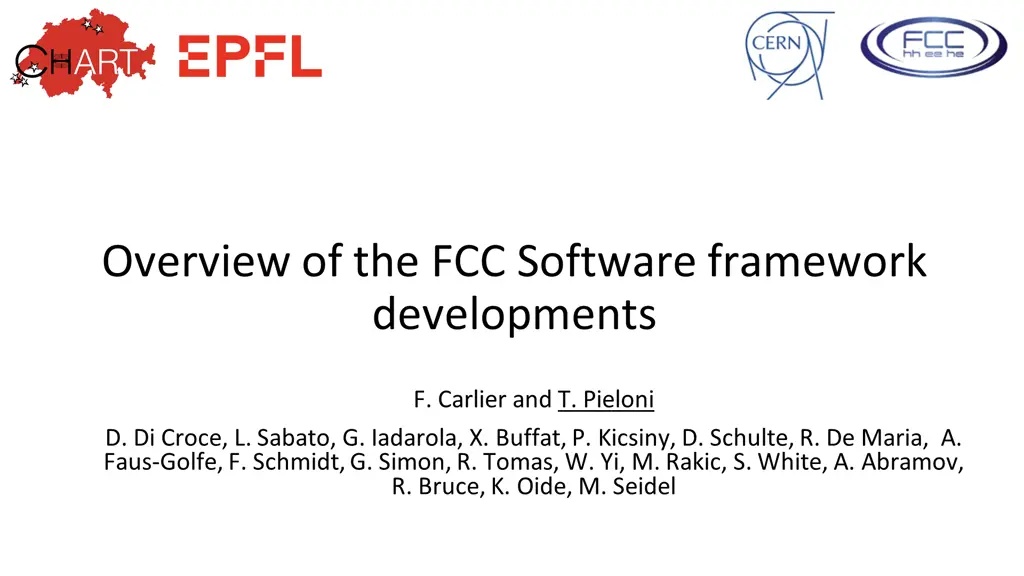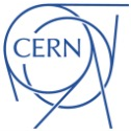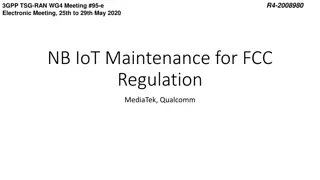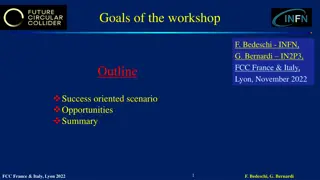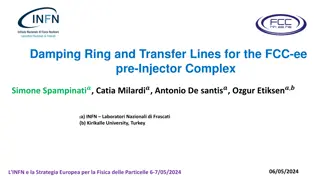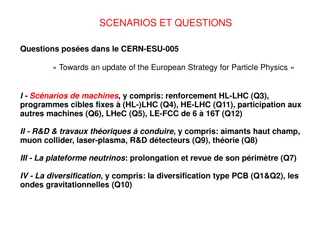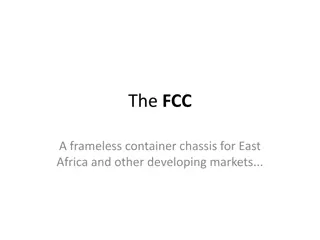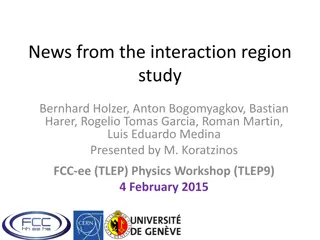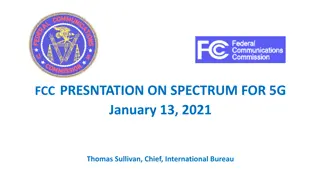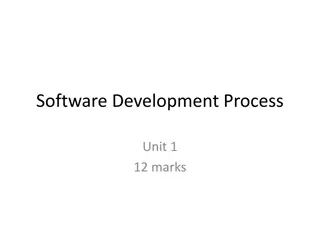Overview of the FCC Software framework developments
Overview provides information on the developments of the FCC Software Framework (SF) project, including modular software design and simulation capabilities for the Future Circular Lepton Collider (FCC-ee). It covers topics such as beam-beam interactions, lattice descriptions, beam lifetime studies, particle losses, and collective effects. The project aims to create a robust and modern tool for the hadron and lepton community, with a focus on reproducibility and collaboration.
Download Presentation

Please find below an Image/Link to download the presentation.
The content on the website is provided AS IS for your information and personal use only. It may not be sold, licensed, or shared on other websites without obtaining consent from the author.If you encounter any issues during the download, it is possible that the publisher has removed the file from their server.
You are allowed to download the files provided on this website for personal or commercial use, subject to the condition that they are used lawfully. All files are the property of their respective owners.
The content on the website is provided AS IS for your information and personal use only. It may not be sold, licensed, or shared on other websites without obtaining consent from the author.
E N D
Presentation Transcript
Overview of the FCC Software framework developments F. Carlier and T. Pieloni D. Di Croce, L. Sabato, G. Iadarola, X. Buffat, P. Kicsiny, D. Schulte, R. De Maria, A. Faus-Golfe, F. Schmidt, G. Simon, R. Tomas, W. Yi, M. Rakic, S. White, A. Abramov, R. Bruce, K. Oide, M. Seidel
FCC Software Framework (SF) Project Executive Abstract: Develop a modular and expandable software framework for FCC-ee design and simulation work. Includes a multi-turn, multiple interaction points model of a Future Circular Lepton Collider (FCC-ee) including a full lattice description with errors, beam-beam modules, beamstrahlung, radiative Bhabha scattering and strong damping for beam lifetime and particle losses studies in a self-consistent approach. Allow studies of collective effects interplay. FCC stability project : electron cloud studies ML4FCC project with Suisse Data Science Center (SDSC) Recently approved polarization project www.chart.ch
FCC Software Framework - Review of available tools: pyAT, Sixtrack/Xtrack, BMAD, GUINEAPIG, - Identify key parts/components of the development fundamental for FCC-ee studies - physics models (Beam-Beam, BS, lattice description, impedance, e-cloud ) - technical needs and benefits (different codes, speed, computing resources) - Great synergies with CERN ABP Computing WG developments and modernization develop a common, modern and robust tool for hadron and lepton community maintenance, reproducibility of results, extensive testing and debugging - Define a general strategy for the developments to open tools to a larger community/collaboration i.e. FCC-ee, FCC-hh, muon, light sources GOAL: prepare for a simulation campaign where several effects interplay
XSUITE for LHC, HL-LHC and Injectors Project launched to rationalize and modernize software for multiparticle simulations ? Moved from a heterogenous range of programs each with limited capabilities to an integrated modular toolkit (Xsuite) o Covering with a single toolkit injectors, LHC, HL-LHC and design studies (FCC Framework) o Exploitation of modern computing platforms (e.g. GPUs) for a wide range of applications o Strong simplification of development and maintenance process (removes several duplications) G. Iadarola R. De Maria and BE/ABP
Xsequence/Xconverter Codes Import Export Xsequence package being developed in the framework of FCC-ee in order to: Simplify lattice conversions to the different codes of interest Offer an expandable platform for users to contribute tools for specific conversions Simplify the creation of models for the large simulation campaigns by controlling errors and tuning knobs Description of circuits using xdeps package (R. de Maria) Ensure model consistency between platforms for comparative simulations MAD-X (cpymad) SAD pyAT Xsuite Bmad Elegant For more details: https://indico.cern.ch/event/1085318/ 7
Tapering was developed for Bmad and pyAT Loss of energy due to synchrotron radiation changes strength of: Dipoles Sawtooth orbit offsets throughout accelerator Other magnets Perturbation of optics SAD comparison (L. van Riesen-Haupt) https://indico.cern.ch/event/923801/ Bmad (F. Carlier) https://indico.cern.ch/event/1018475/ pyAT (S. White, M. Rakic, F. Carlier) https://indico.cern.ch/event/1018475/ F. Carlier https://indico.cern.ch/event/995850/ Tapering scheme: Adjusting magnetic strengths to compensate for energy loss and retrieve reference orbit and optical functions Tapering A. Abramov FCC-ee Collimation Studies at 16:45.
Beam-Beam, Beamstrahlung, Synchrotron Radiation Beam-beam simulations: SS, WS, Quasi SS Beamstrahlung effect implemented and benchmarked First pilot studies for FCC-ee are ongoing including: o Synchrotron radiation o Strong-strong and Weak-strong 6D beam beam o Beamstrahlung Next steps: Bhabha Scattering Crab Waist scheme P. Kicsiny Simulations of FCC-ee beam-beam effects with xsuite this session
Lattice, imperfections and radiation Invest on MAD-X code to create a solid platform for FCC-ee MAD-X already used for FCC-ee studies, has synergies with many other projects. Radiation effects in MAD-X used in many FCC-ee studies: Few calculations have shown inconsistent results related to thin multipole elements and solenoid Some usability issues have been identified related to tapering in the last version Stabilize radiation calculations in MAD-X Review and document radiation related physics applied to MAD-X Compare calculations on FCC-ee or other test lattices using different methods such as direct tracking, map formalism, radiation integral formalism Coordinate with optics studies for defining priorities such as interaction region modelling and vertical emittance studies R. De Maria talk on MADX in this session
Lattice, imperfections and radiation Investigating different tracking methods in MADX Identified and corrected bug in TRACK for thin multipole resulting in incorrect damping times Collected other issues that are under investigations: 1) tapering introduces optics beating 2) equilibrium emittance not correct for tilted solenoid 3) twiss energy loss does not take the gamma of the closed orbit correctly into account 4) issue with radiation of multipoles in track and emit 5) adding ktap on additional elements 6) synchrotron radiation integrals zero with zero length elements Deterministic damping G. Simon poster session Thursday 17:30: Synchrotron radiation improvements in MAD-X for FCCee studies
Polarization and Spin dynamics 1. First simulations of spin dynamics in Bmad for FCC-ee Allows full lattice description, errors, misalignments and corrections. Comparison of Bmad vs. SITROS in linear and nonlinear spin simulations Study the effects of machine errors on achievable polarization and the possible need of spin orbit matching. Y. Wu EPOL2 session Thurs 9am: Simulations of the Spin Polarization for the Future Circular Collider e+e using Bmad 1. Spin part of Madx-PTC has been compared to Bmad-PTC to good agreement. Calculation of linear polarization limits still need to be developed using Madx-PTC output. More details at link. The goal is to use the developed codes to study resonant depolarization for energy calibration using full lattice descriptions. Project approved by CHART starting on 15th July.
Electron Cloud studies and developments Improve the model of the electron cloud formation based on the current state of knowledge (from both lab and the LHC experience): i.e. improvement of the energy spectrum model of the emitted electrons using lab measurements Validate the existing numerical tools for electron cloud build-up based on the LHC RUN3 data set Development code and benchmark of PyECLOUD for Xsuite in the software framework for FCC By using the results of the model, propose modifications for the design of the vacuum chambers of the FCC in terms of shape, material, coating or surface treatment Contribute to the development of a framework for comprehensive beam dynamics simulations on the combined effect of persisting electron cloud, beam-beam and impedance aiming at the prediction of stability limits and beam lifetime evolution during collisions Details at link. 17
ML4FCC PROJECT Higher computational complexity for FCC Multiple effects; Synchrotron radiation, 6D beam-beam interactions, beamstrahlung, impedance, lattice, polarization need for computational resources, automatized simulation submissions, analysis and optimization of parameters possible use of ML details at link BOINC system ideal to submit jobs for FCC tracking simulations! An improved tracking simulation tool has been developed Xtrack (part of Xsuite) BOINC app for FCC simulation is being developed to involve worldwide volunteers to the global effort of designing a Future Circular Collider vis the LHC BOINC system FCC@home Possible to develop GPU support for BOINC app Develop an active learning framework to continuous update the DA model with new simulated data in order to explore new parameter space Provide FCC (DA) model and tuning knobs for machine design and optimization.
Summary Simulating the beam dynamics for the FCC-ee is a challenging goal! Multiple effects will need to be studied together for a final and robust understanding and design Design and Optimization of the machine parameters can profit of novel technologies for speed, reproducibility and automatization of tuning Developments should be done profiting from different communities: lepton colliders, light sources, hadron colliders Simulations tools are fundamental to permit reproducibility, good practise, involve younger generations Synergieswith the CERN Computing WG are fundamental to guarantee maintainability of tools in a long term prospective, profit of expertise in modelling and constant testing
Many developments are on-going and first results presented: P. Kicsiny Simulations of FCC-ee beam-beam effects with xsuite R. De Maria talk on MADX developments in this session A. Abramov FCC-ee Collimation Studies Y. Wu EPOL2 session Thurs 9am: Simulations of the Spin Polarization for the Future Circular Collider e+e using Bmad G. Simon poster session Thursday 17:30: Synchrotron radiation improvements in MAD-X for FCCee studies Comments, ideas, contributions are very welcome! EPFL-LPAP FCC-ee Software Framework Meetings: https://indico.cern.ch/category/9606/
Beam-beam interactions for muon collider X. Buffat Xsuite used for first studies on beam-beam effects in recirculating linac for muon collider
Electron Cloud studies and developments Improve the model of the electron cloud formation based on the current state of knowledge (from both lab and the LHC experience) Improvement of the energy spectrum model of the emitted electrons, using lab measurements [] B. Henrist et al., Secondary Electron Emission Data for the Simulation of Electron Cloud , cds 2002. 23
ML4FCC PROJECT Dead after N turns GNN for 3D/4D DA border detection producing synthetic data Xtrack BOINC app development standalone binary available for Windows and Linux + test server and test application ready to test BOINC API DA regressor and particle loss GAN for various configurations of accelerator DA regressor developed using existing Sixtrack data while preparing to produce FCC- ee Xtrack simulation Test MAE = 6%
